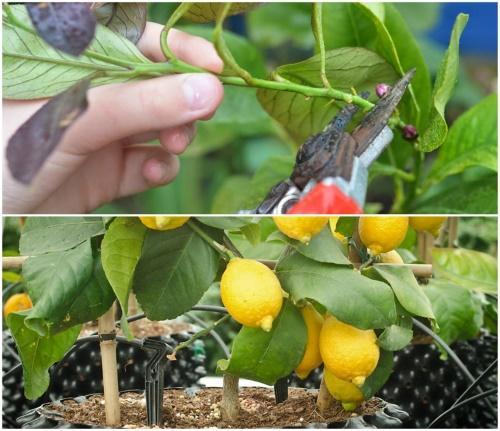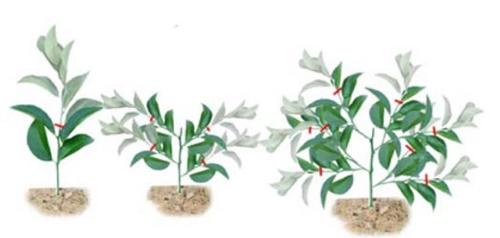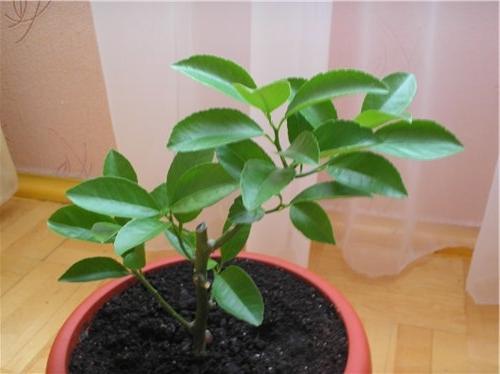Basic rules on how to cut lemon at home
 Indoor lemon is not a rarity on our windowsills for a long time. It's not difficult to grow it planting bones from regular lemons that we buy in stores. However, if you want a beautifully shaped tree, watering is not enough. Lemon, like most houseplants, needs proper shaping. Knowing how to prune a lemon at home can give it a curvy shape and harvest. Although citrus fruits themselves can branch, but without the participation of a grower, this process is chaotic. Most often, a lemon growing "by itself" forms a tall tree with long shoots that interfere with each other. Timely and competent pruning will help direct the growth of the plant in the right direction and form a beautiful crown. Moreover, it must be started at the early stages, when young seedlings are actively growing up.
Indoor lemon is not a rarity on our windowsills for a long time. It's not difficult to grow it planting bones from regular lemons that we buy in stores. However, if you want a beautifully shaped tree, watering is not enough. Lemon, like most houseplants, needs proper shaping. Knowing how to prune a lemon at home can give it a curvy shape and harvest. Although citrus fruits themselves can branch, but without the participation of a grower, this process is chaotic. Most often, a lemon growing "by itself" forms a tall tree with long shoots that interfere with each other. Timely and competent pruning will help direct the growth of the plant in the right direction and form a beautiful crown. Moreover, it must be started at the early stages, when young seedlings are actively growing up.
How to cut lemon at home - step by step procedure

The further procedure for forming a room lemon is to prune it annually in this way:
- In the second year of life, you need to shorten the side branches.
- For 3-year-old lemon, young stems should also be pruned to stimulate lateral bud awakening.
- In the fourth year of the tree's life, cut off the tops of young formations. Thin the crown by removing branches growing inward.

If the lemon, after pruning, stubbornly does not want to give several shoots, it is necessary to persistently remove the top until several buds are formed. In case, if the tree gives a strong vertical twig, it can be left by pinching and giving a horizontal direction of growth. To do this, wrap the shoot with soft wire and bend it, fixing the wire around the pot.
Tops and those twigs that will form in the middle of the crown must be removed annually. This will avoid thickening and maintain the desired round shape. At the 5th year of life, you can give the lemon the opportunity to bear fruit - by this time it will already be strong enough.
Pruning buds to regulate the fruiting of homemade lemon
 Indoor citrus fruits not only have a spectacular decorative look. With proper care, they will delight with a harvest of albeit small, but very fragrant lemons. However, if your tree has decided to thank you with fruits, it is worth interfering with the natural process. If there are too many ovaries, the lemons will grow small and the tree itself will use up more energy. Therefore, it is necessary to count the inflorescences and remove the excess. Only the number of ovaries should remain, which a young plant can provide with adequate nutrition without prejudice to its development. Depending on the age of the lemon, it is allowed to leave:
Indoor citrus fruits not only have a spectacular decorative look. With proper care, they will delight with a harvest of albeit small, but very fragrant lemons. However, if your tree has decided to thank you with fruits, it is worth interfering with the natural process. If there are too many ovaries, the lemons will grow small and the tree itself will use up more energy. Therefore, it is necessary to count the inflorescences and remove the excess. Only the number of ovaries should remain, which a young plant can provide with adequate nutrition without prejudice to its development. Depending on the age of the lemon, it is allowed to leave:
- no more than 3 inflorescences - for a plant up to 3 years old;
- up to 7 ovaries - for a 5-year-old tree;
- about 10 buds - for lemon over 7 years old.